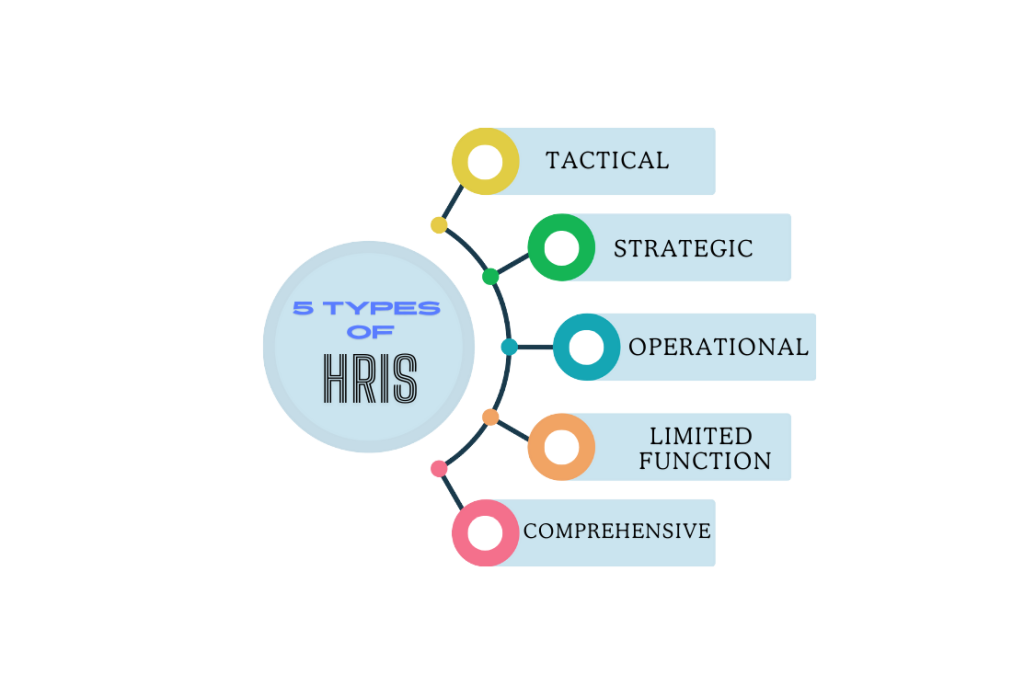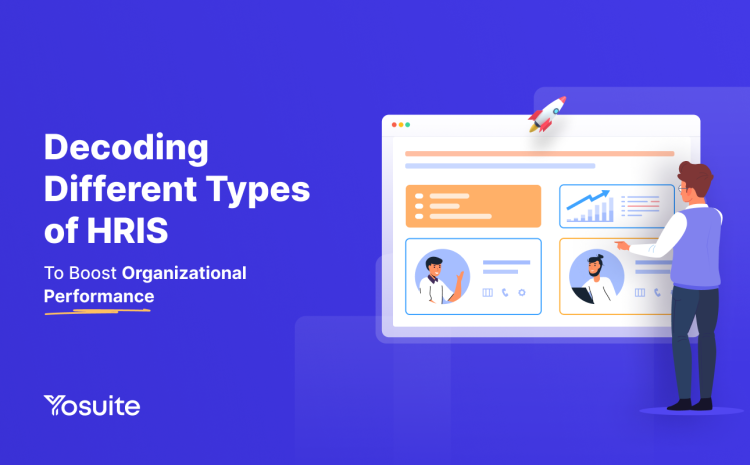Did you know that, as per a recent report by Forbes, around 80% of organizations use HR software like HRIS?
HRIS works as the focal point of your data. Without it, HR team’s day-to-day operations would be a agonizing!
Here, we will delve into the types of HRIS systems and their benefits. We will also discuss how to install them to boost organizational performance.
Purpose of HRIS
HRIS, in full, means Human Resources Information Systems. It is a solution that enables integration and automation of your organization’s HR functions under one central hub.
Think of it as a virtual ‘warehouse’ where you store all your HR-related inventory (data, records, and information). You can access the information and analyze it to create reports or make decisions from analytics.
HRIS aims to help make informed and accurate decisions from insights, stats, and up-to-date records. HR analytics is a key driver of the different types of HRIS. Different types of HRIS software present data which offers valuable analytics source.
Features of HRIS Systems
The following HRIS features benefit organizations and their overall performance:
Recruitment & Selection Support
HRIS software supports an organization’s recruitment and staffing needs, from first job posting to new hire onboarding. It can analyze and track candidate information and resumes, enabling recruiters to shortlist suitable applicants for the opening at hand.
You can never undermine the role of HR software in onboarding new employees! For instance, an Applicant Tracking System (ATS) is an integral part of onboarding the right candidates from a company’s applicant pool and kick-starting the hiring process. This application syncs with the HRIS app, ensuring recruitment data availability at your fingertips.
Employee Data Management
Proper recordkeeping is an essential part of HRIS. It acts as the central storage for all employee data that HR or other authorized personnel can access to create reports, make decisions, or predict trends.
Reporting, Data Analysis & Analytics
Many type of HRIS software manage a comprehensive set of people data. These HR Analytics Software are used for enhanced insights and predicting trends.
The reports generated have a lasting impact on an organization’s productivity and business plans.
Attendance, Shift, and Leave Administration
HRIS system manages leave & attendance. The system maintains in and out times, roster shifting times, and absence records. In addition, HR personnel can track different types of leaves and the employees’ reasons for it; something that impacts appraisals.
Payroll & Benefits Calculation and Automation
Tracking attendance or work hours helps HR in ensuring correct payroll management as well. The latest HRIS systems automate the payroll processes, synced with attendance and leave records.
Also, if you consider employee benefits as a component of the annual salary, then streamlining the payroll process becomes paramount. HRIS assists in storing, tracking, and updating benefits administration records.
Employee Separation & Offboarding formalities
Most types of HRIS systems enable you to track the formalities of a leaving employee. HR personnel benefit from storing and analyzing information of a separated employee.
This feature boosts tracking data, especially when massive layoffs or downsizing occur in an organization.
Different Types of HRIS Systems

Generally, HR people implement five types of HRIS systems based on the scope of their functions. They are as follows:
Limited Function
A limited-function HRIS specializes in one or a few core HR functions, like payroll & benefits administration or recruitment.
Like other types of HRIS, this system also collects, stores, and tracks personnel data like
- Full name
- Present & permanent address
- Nationality or citizenship
- Academic background
- past work experiences
And other relevant data.
Because limited-function HRIS platforms are usually less expensive than other HRIS types, a single user can operate this software without much hassle. Startups or small-medium businesses with lean HR teams prefer this type of HRIS.
Operational
Operational HRIS systems manage the daily HR tasks like hiring, promotions, transfers, HR workflows, administrative documentation, and employee facilities-related tasks.
ATS and performance management systems (PMS) software are two prevalent examples.
Strategic
Strategic HRIS systems assist HR in analysis and decision-making, as per the goals of the HR Department and company objectives.
For instance, this type of HRIS software has integrated workforce planning to help HR teams identify the necessary knowledge, skills, responsibilities, aptitude, and salary for particular roles. This job analysis helps match currently suitable employees to vacant roles or fill gaps in the current workforce. Eventually that either results in extensive employee development initiatives or a new recruitment process.
Talking of employee development, the learning management system (LMS) is another feature that strategic HRIS provides. It enables HR to identify employees who are either ready to pursue new training to match their new roles or responsibilities or simply identify employees who need to improve their skills.
Tactical
Tactical HRIS solutions enhance work efficiency and compliance with internal workforce processes. This type of HR information system expedites HR decision-making on optimally utilizing manpower or other resources for salary administration, recruiting, training, employee engagement, and benefits administration.
These modules are also used to collect external data related to competitors, industry, labor markets, and legal requirements. For example, software that tracks compensation data across various markets or stores information on tax rules of specific geographic regions falls into this type of HRIS system.
Comprehensive
The comprehensive type of HRIS offers a one-stop solution for all data and information that HR needs. It is designed as a total package of operational, strategic, and tactical modules.
For instance, it has information about where a position fits into the organization’s hierarchy and how to use the role to drive the company forward. Both these aspects serve operational and strategic angles of job analysis and design.
Usually, larger businesses or corporations opt for comprehensive HRIS.

Benefits of HRIS Systems
So, what do you or your HR team get by implementing the different types of HRIS systems? Let’s look:
Centralized data storage:
Comprehensive HRIS works as a central hub for all HR information related to employees and potential hires. This helps to access data needed on who to hire, release, or promote against competent roles, saving the time of navigating to various points.
Enhanced Reporting Capabilities:
Having one-stop or structured storage for all data expedites report generation and presentation. Whether it’s a tactical, strategic, or operational HRIS, you save both time and costs as only one or a few users can collect, analyze, and create the reports from the system.
Efficient Attendance and Leave Management:
Automated entries of ins and outs or recording staff on leave speeds up record keeping of leaves and attendance. HR can create multiple reports against KPIs to identify the consistency of employees in maintaining discipline, too. This benefit is best used with comprehensive, strategic, and operational HRIS.
Automating salary & benefits administration:
Updated and efficient HRIS systems assist in salary calculation and automation, ensuring proper and timely salary disbursement. In addition, tracking performers eligible for benefits reduces the extra time and effort of HR personnel. If your firm is using any HRIS type, you can benefit from this aspect, as payroll or salaries are a key element of HR planning and decision-making.
Simplifying HR responsibilities:
HRIS software assists HR personnel perform daily tasks. If AI automation is involved, HR teams can maximize efficiency and simplify task roles. HRIS streamlines bulk operational tasks like data inputting and recording, helping HR focus more on planning and decision-making.
Improved HR Productivity:
If an automated system can keep track of progress, record changes, generate reports accordingly, and inform of possible problems with data-driven insights, productivity levels rise, as HR can now focus on more strategic aspects of the organization. All types of HRIS systems help improve productivity.
Understanding the HRIS Life Cycle
The HRIS Life Cycle is the implementation of the HRIS system and all matters related to integrating it with the organization’s HR functions.
A successful implementation ensures:
- Improved efficiency and accuracy
- Smooth accessibility of HR data
- Better HR decision-making
- Enhanced employee experiences
The steps of the HRIS life cycle are:
1. HR Needs Analysis
This first step is where you analyze and determine why you need an HRIS. Your planning in this stage eventually determines the success of the system, evaluated against the goals here.
2. Choosing an HRIS System
After planning, it’s time to select the type and supplier of your HRIS solution. And, as Software Path 2022 HRIS Report indicated, it’s not so easy, with companies taking around 15 weeks, on average, to choose an HRIS.
Here, you should:
- Search and select the vendor or supplier of your HRIS software. Not all HRIS vendors will suit your needs or budget.
- Check the available features of various HRIS software or vendors. Depending on your specific needs, budget, and longevity of the implementation, you can move forward with a type of HRIS system.
- Compare costs of possible vendors through RFQ/RFPs. Cost factors include installation, retainer, maintenance, upgrades, and/or after-sales support costs.
- Assess the compatibility, flexibility, and scalability of the HRIS system with your business and HR operations. The right HRIS system should be able to scale with your business, customizing or increasing its parameters without losing out on performance.
- Evaluate the system’s data security strength. This is a crucial factor in today’s time with the alarming cybersecurity issues worldwide.
- Finally, choose the HRIS software for testing and implementation.
3. Preparing Resources
Implementing a new HRIS system needs a detailed action plan outlining the process, goals, and roles for it. You would need to assign clear roles and responsibilities and avoid possible conflicts that can arise during the adaptation of the HRIS.
You may require additional tools or software to accommodate the system. And train the assigned people on its usage.
4. Implementing the System
Once resources are ready, roles clarified, and processes in place, you can now integrate and launch the system. Make sure that a POC from the vendor end is available during the initial days unless it’s in-house software.
5. Monitoring and Updating
Constant monitoring will help to identify potential issues or bottlenecks at any stage of the system’s life. Also, HR personnel need to continually check for system upgrades or market changes, so that HRIS does not become backdated.
With your HRIS system up and running, constantly track key performance indicators (KPIs) like system efficiency, user compatibility, and data accuracy to evaluate the system’s overall impact on the organization. And, improve if needed.
Final Words
HRIS systems boost organizational performance when implemented effectively and correctly. To know how to best implement HRIS systems, you first need to know how you want it. And, how much of it do you want?
Also, you should check for current trends and future trends in HRIS implementations. Cloud computing, AI, data analytics, mobile accessibility, etc. play a vital role in shaping HRIS system design and use.
Eventually, the type of HRIS you opt for should meet your desired company goals and budget, along with streamlining your HR processes to the fullest



Leave a Reply